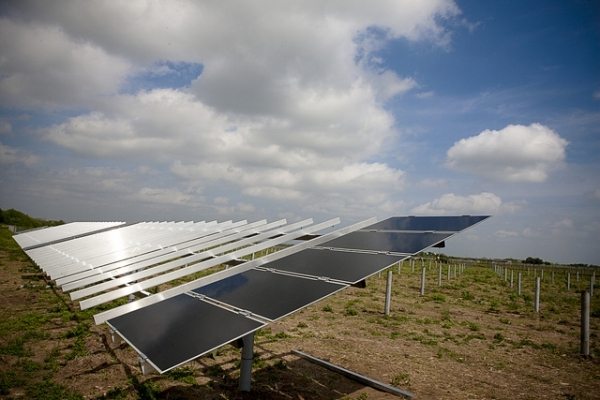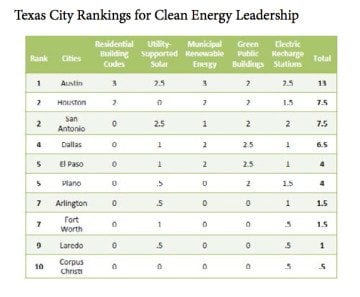
Austin, Houston and San Antonio Lead Texas Cities in ‘Green’ Policies

Above: Duke Energy's 14-megawatt Blue Wing Solar Project in San Antonio.
Major Texas cities are challenging Texas’ rank as one of the least-green states in the union, a new report shows. The report, released by Environment Texas in San Antonio today, ranks Texas’ 10 most populous cities by environmental and energy efforts, and emphasizes the need for improvement statewide.
The cities are rated on a scale of zero to three in five categories that focus on renewable energy and efficiency. Some of the scales compare Texas cities to others in the nation. For example, a city could only score a three in utility-supported solar power if its solar production rivaled that of U.S. cities leading in solar.

Perhaps not surprisingly, Austin is the greenest city, with San Antonio and Houston (!) tied for the no. 2 spot. Corpus Christi (“The Sparkling City by the Sea”) brought up the rear, with a score of 1 out of a possible 15.
But the scales used to rank cities were limited and narrow—while some important categories like municipal use of renewable energy were included, Environment Texas didn’t consider water use, air quality and public transit.
San Antonio and Austin took the lead in solar power, each earning a 2.5 out of 3. Both cities own their utilities and together comprise 85 percent of Texas’ solar capacity. But the two cities still only produce about a third of what national leaders San Jose and San Diego produce per capita (those cities would have earned a three). Houston earned high marks in all categories, but scored a zero in solar. Despite boasting more solar potential than any other state, Texas still ranks 20th for solar energy production per capita. State leaders have done very little to boost the industry, leaving a handful of big cities and a few utilities to lead the way.
In a state with a booming construction industry—Texas accounted for 16.3 percent of all building permits issued in the U.S. last year—cities’ commitment to energy efficiency and other green measures in new buildings is paramount. Of the 10 cities, only Austin has adopted the latest International Energy Conservation Code‘s efficiency standards for new homes. Only 20 smaller Texas cities have adopted the newest standards, while most still adhere to the 2009 version.
Texas mandates adherence to the 2009 code, but the report says the 2012 code would achieve “approximately 15 percent greater efficiency” than the old one. Houston kept the 2009 code but amended it to require 15 percent more efficiency by 2014, and also requires that all new homes be built solar-ready.
Texas cities did well in other categories: Austin uses 100 percent renewable energy to power municipal activities, while Houston uses 48 percent, making it the largest municipal purchaser of renewable energy in the U.S. Houston also leads in green construction, ranking 5th in the country for the number of LEED-certified buildings. And while six of the ranked cities require all public buildings to earn a LEED-Silver designation, Dallas requires LEED-Gold.
The report found that all major Texas cities have at least one recharge station for electric cars per 100,000 residents. Austin has 19 charging stations per 100,000 residents, while San Antonio has 10 and Houston nine per 100,000.


